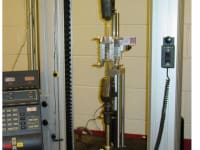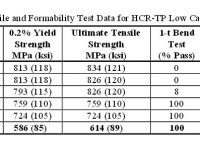A new class of heavily cold rolled and thermally processed (HCR-TP) sheet metals is proposed as a viable low cost alternative to producing light weight vehicles for the transportation industry. Presently, automobile and light truck manufacturers are adapting to rising fuel costs by lightweighting vehicles and making revolutionary changes to powertrains. This new class of materials is based on ferrous and nonferrous sheet metals and alloys that can provide the industry with a highly sought combination of features and properties – light weight, high strength, good formability, and low cost. The new class of HCR-TP materials of choice includes low carbon and low alloy steels that are heavily cold rolled to achieve high strength, and the nonferrous materials of choice are heavily cold rolled 3xxx and 5xxx aluminum alloys, now widely used in can making.
Cold rolling is one of the lowest cost methods of developing strength in metallic sheet and plate, and the selection of the base ferrous and nonferrous metals and alloys for HCR-TP materials is predicated on economics, therefore, high strength is achieved at low cost; high strength in turn allows designers to reduce section thickness and thus achieve light weight. Although strength and ductility/formability are inversely related characteristics of metals, the overall concept proposed here includes specially designed heat treatments that improve general and localized formability. Such heat treatments include partial annealing of the entire sheet to improve ductility/formability with slight reduction in strength, supplemented where needed with localized partial or full annealing to impart good formability to the sheet metal where needed.
The issue of low elongation in heavily cold worked HCR-TP lightweight metals is addressed by data showing how such partially annealed sheet metals approach or exceed strength levels of high strength dual phase steels, while exhibiting high levels of ductility measured by a specially developed test utilizing continuous bending under tension (CBT, as well as 1T bend tests, and flange width tests. Advantages of further localized partial or full annealing of the sheet in areas requiring enhanced formability have shown that HCR-TP materials are viable candidates to replace the more expensive alternative sheet materials such as advanced high strength steels, age hardenable aluminum alloys, carbon fiber reinforced composites, and magnesium alloys. Optimization of the proper balance of strength and ductility of HCR-TP materials needs to be achieved by computer modeling and integration of composition, partial annealing processing, and localized partial or full annealing for particular vehicle models. The low cost of HDR-TP materials will make it possible to extend the benefits of lightweight structures for fuel economy to a broad range of automotive vehicles.
Like this entry?
-
About the Entrant
- Name:Joseph Benedyk
- Type of entry:individual
- Software used for this entry:To be developed.
- Patent status:none





